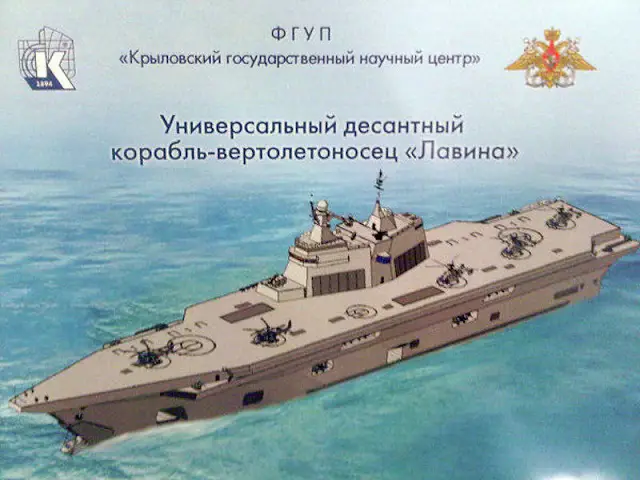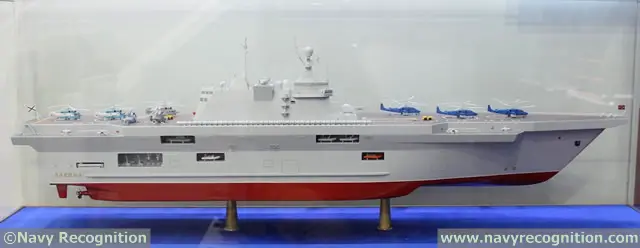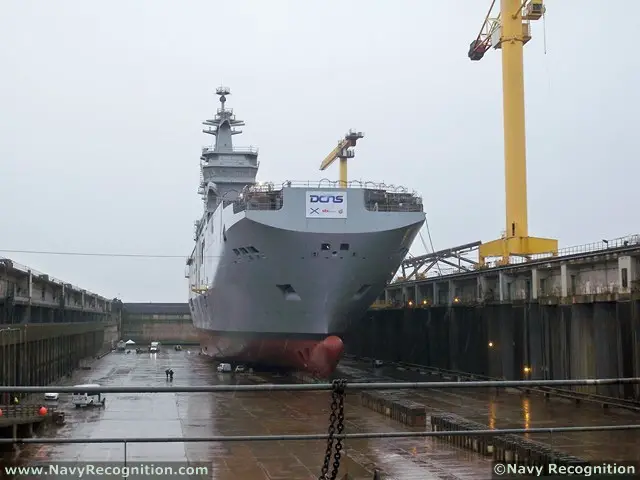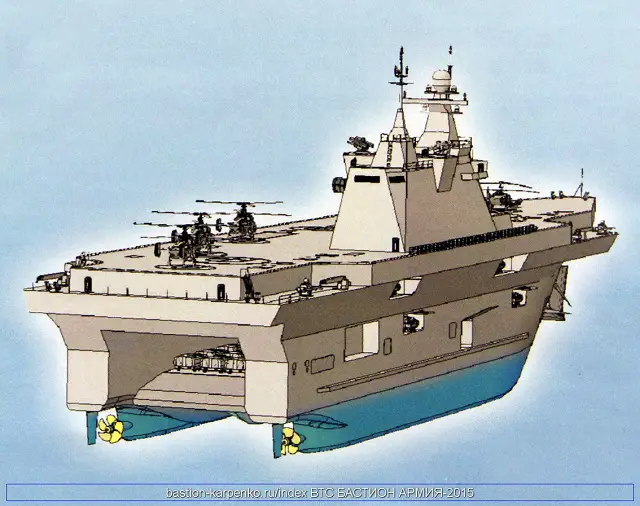Experts Doubt Russia’s ability to build two LHD Amphibious Assault Ship by 2027
|
|
|||
 Image showing Krylov Central Scientific Research Institute's Avalanche (Lavina) Project with the official seal of the Russian Navy. Image showing Krylov Central Scientific Research Institute's Avalanche (Lavina) Project with the official seal of the Russian Navy. |
|||
|
Judging by the report posted by TASS, our designers’ concept is much broader. The Russian Navy should receive ships that can not only land assault teams and support them with fire from the air, but also deliver strikes from the Ka-52Ks against enemy warships, and effectively search for and destroy enemy submarines using the Ka-27s. With such a flagship, a naval task force in the same Mediterranean Sea would have felt much more confident.
However, there are grounds for doubt. Just a few days ago, Deputy Defense Minister Yury Borisov spoke on the same subject about the prospects for building the ULS. According to him, the construction cycle would take about four years. Borisov even called the possible delivery date for the first such ship to the Navy: "Somewhere in 2022." It turns out that in just a week the deadlines for handing over the lead ULS to the Navy slipped two years. And this is despite the fact that the project has been included in the State Armaments Program 2018-2025. |
|||
|
|
|||
 Priboy LHD scale model showcased by Krylov during Army 2016 exhibition. Priboy LHD scale model showcased by Krylov during Army 2016 exhibition. |
|||
|
Is the industry ready to implement such a grandiose project? Apparently, the epic with the Mistrals is inspiring certain optimism among the military and shipbuilders. In 2011, Rosoboronexport and French DCNS signed a contract for the construction of two general purpose dock ships of this type for the Russian Navy, Sevastopol and Vladivostok, at shipyards in Saint-Nazaire. The total amount of the contract was 1.2 billion euros. Of these, Paris received 840 million euros as an advance payment. Under the terms of the deal, the stern sections of both hulls were built by the Baltic Shipyard in St. Petersburg. In Russia, no one has been engaged in the construction of warships with such a displacement since the Soviet times, so the transfer of certain French technologies to us (inevitable under such cooperation) was of definite interest. Moreover, the share of Russian participation in the construction of the hull of the second ship amounted to a considerable forty percent.
Concurrently, development work on a new helicopter was underway. Thus, an exceptionally successful Ka-52K attack helicopter emerged from a purely land-based version, as it turned out during the recent voyage of the Admiral Kuznetsov to the Mediterranean Sea. The deal was canceled due to the events in Ukraine. Paris returned the advance to Russia, while the Mistral LHDs were bought by Egypt. The first Ka-52Ks will likely arrive there, too. So the money remained intact, domestic helicopter builders received a profitable export order, and the Russian Navy received a new attack weapon. And, of course, the Baltic Shipyard gained certain experience. |
|||
|
|
|||
 The former Russian Navy Mistral class LHD Vladivostok The former Russian Navy Mistral class LHD Vladivostok |
|||
|
According to Sergei Vlasov, CEO of the Nevsky Design Bureau, "there are no fundamentally new technologies in the French project that would necessitated placing the order abroad." However, what about the fact that the epic with the construction of the 5,000-ton Project 11711 large landing ship Ivan Gren, close to the ULS in purpose (but not in size!) has been going on in Kaliningrad since 2004. For various reasons, the deadlines for delivery of Ivan Gren to the Navy have slipped again and again. The initial plans to get six of these ships have been long abandoned. And this is when every unit of this class in Syria counts.
The Priboy project developed at the Nevsky Design Bureau will probably be taken as the basis of the future Russian ULS. At least, such a mock-up was on display at the Army 2015 International Military Technical Forum, which was visited by Russian President Vladimir Putin himself. If so, it’s about a ship with a displacement of about 14,000 tons (Mistral LHD displaces 21,000 tons). Despite its smaller dimensions, the Priboy will be able to take on board about the same number of troopers as the Mistral (500 marines). This figure was achieved through a significant reduction in the air group strength - the mock-up of the Priboy accommodated eight helicopters against 16 on the Mistral. The Nevsky Design Bureau has prepared the second version - the universal landing ship Lavina. The ship is innovative in every respect and unique even in architecture: this is a semi-trimaran, that is, it combines the outlines of single-hull vessels and trimarans. It is one and a half times larger than the Priboy (24,000 tons). The troop capacity is the same, but the number of helicopters on board is twice as big - 16 against eight. |
|||
|
|
|||
 Image showing Krylov Central Scientific Research Institute's Avalanche (Lavina) Project Image showing Krylov Central Scientific Research Institute's Avalanche (Lavina) Project |
|||
|
The timing of the construction of any of the options for a new helicopter carrier is far more important for the Russian Navy. Borisov claims that four years for each ship will be enough.
The French shipyard in Saint-Nazaire, which has been building such universal ships for a long time, spends a mere 12 months less for each ship. This is with mature technologies and production chains, with the availability of experienced specialists. In an article posted in the online publication Free Press, expert Sergei Ischenko doubts that the Russian defense industry is ready to start working at almost the same pace as a well-established conveyor in Saint-Nazaire. © Copyright 2017 TASS. All rights reserved. This material may not be published, broadcast, rewritten or redistributed. Navy Recognition Comment Russian Krylov State Research Center has developed the Priboy LHD on its own initiative. It is significantly different from the Mistral landing helicopter dock designed by French DCNS. Priboy is intended for seaborne movement of troops and military equipment and landing on beaches during amphibious operation in conjunction with other naval forces. It can support projection of soldiers and hardware, take part in offensive mining actions and mount sonar beacons of suspended array surveillance systems. Priboy has a normal surface displacement of 23,000 t, a length of 200 m, a width of 34 m, a designed draft of 7.5 m, a full speed of 20 kn, a cruise speed of 14 kn, an endurance of 6,000 nmi or 30 days. The LHD can withstand storms of force 6-7 on the Beaufort scale (strong breeze/near gale). The ship has a crew of 400 sailors and can transport 500-900 soldiers, about 50 infantry fighting vehicles (IFV) and 10 main battle tanks (MBT). Up to 12 military-transport and search-and-rescue (SOR) helicopters can be based on Priboy. The ship incorporates six fast landing craft with 45 t lifting capacity each and six assault boats located on davits. The Priboy`s armament suite includes two anti-air gun-missile combat modules, two close-in weapon systems and one 76mm naval gun. |
|||



























 Priboy LHD scale model showcased by Krylov during Army 2016 exhibition.
Priboy LHD scale model showcased by Krylov during Army 2016 exhibition.